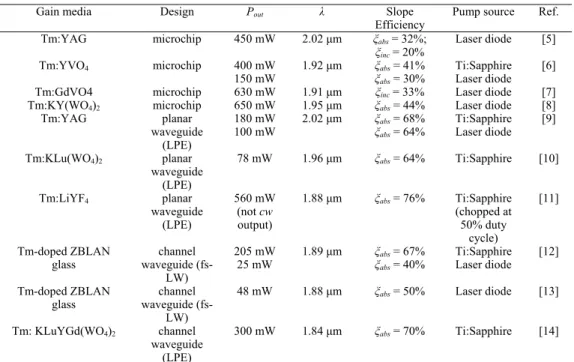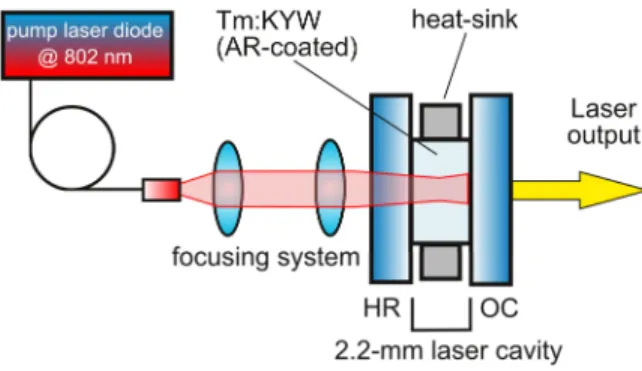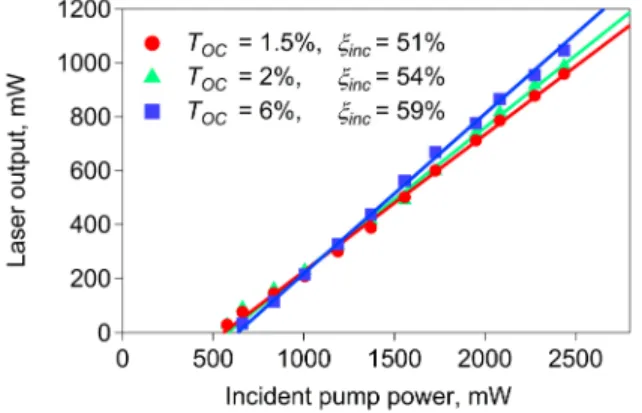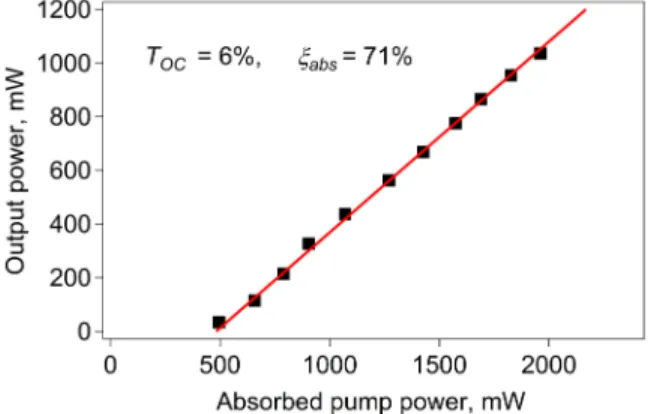Efficient diode-pumped Tm:KYW 1.9-μm
microchip laser with 1 W cw output power
Maxim Gaponenko,1,* Nikolay Kuleshov,2 and Thomas Südmeyer1 1Laboratoire Temps-Fréquence, Université de Neuchâtel, Ave. de Bellevaux 51, Neuchâtel, Switzerland 2Center for Optical Material and Technologies, Belarusian National Technical University, Nezavisimosti Ave. 65,
Minsk, Belarus
*maxim.gaponenko@unine.ch
Abstract: We report on a diode-pumped Tm:KYW microchip laser
generating 1 W continuous-wave output power. The laser operates at a
wavelength of 1.94 μm in the fundamental TEM00 mode with 71% slope
efficiency relative to the absorbed pump radiation and 59% slope efficiency relative to the incident pump radiation. The optical-to-optical laser efficiency is 43%.
OCIS codes: (140.3580) Lasers, state; (140.5680) Rare earth and transition metal solid-state lasers.
References and links
1. A. A. Lagatsky, S. Calvez, J. A. Gupta, V. E. Kisel, N. V. Kuleshov, C. T. A. Brown, M. D. Dawson, and W. Sibbett, “Broadly tunable femtosecond mode-locking in a Tm:KYW laser near 2 μm,” Opt. Express 19(10), 9995–10000 (2011).
2. P. Koopmann, R. Peters, K. Petermann, and G. Huber, “Crystal growth, spectroscopy, and highly efficient laser operation of thulium-doped Lu2O3 around 2 μm,” Appl. Phys. B 102(1), 19–24 (2011).
3. N. Coluccelli, G. Galzerano, F. Cornacchia, A. Di Lieto, M. Tonelli, and P. Laporta, “High-efficiency diode-pumped Tm:GdLiF4 laser at 1.9 μm,” Opt. Lett. 34(22), 3559–3561 (2009).
4. T. Y. Fan, G. Huber, R. L. Byer, and P. Mitzscherlich, “Spectroscopy and diode laser-pumped operation of Tm,Ho:YAG,” IEEE J. Quantum Electron. 24(6), 924–933 (1988).
5. F. F. Heine and G. Huber, “Tunable single frequency thulium:YAG microchip laser with external feedback,” Appl. Opt. 37(15), 3268–3271 (1998).
6. A. I. Zagumennyi, V. A. Mikhailov, V. I. Vlasov, A. A. Sirotkin, V. I. Podreshetnikov, Y. L. Kalachev, Y. D. Zavartsev, S. A. Kutovoi, and I. A. Shcherbakov, “Diode-Pumped Lasers Based on GdVO4 Crystal,” Laser Phys. 13, 311–318 (2003).
7. J. J. Zayhowski, J. Harrison, C. Dill III, and J. Ochoa, “Tm:YVO4 microchip laser,” Appl. Opt. 34(3), 435–437 (1995).
8. M. S. Gaponenko, P. A. Loiko, N. V. Gusakova, K. V. Yumashev, N. V. Kuleshov, and A. A. Pavlyuk, “Thermal lensing and microchip laser performance of Ng-cut Tm3+:KY(WO4)2 crystal,” Appl. Phys. B 108(3), 603–607 (2012).
9. A. Rameix, C. Borel, B. Chambaz, B. Ferrand, D. P. Shepherd, T. J. Warburton, D. C. Hanna, and A. C. Tropper, “An efficient, diode-pumped, 2 μm Tm:YAG waveguide laser,” Opt. Commun. 142(4-6), 239–243 (1997).
10. O. Silvestre, M. C. Pujol, M. Aguilo, F. Diaz, X. Mateos, V. Petrov, and U. Griebner, “CW Laser Operation of KLu0.945Tm0.055(WO4)2–KLu(WO4)2 Epilayers Near 2 μm,” IEEE J. Quantum Electron. 43, 257–260 (2007). 11. W. Bolanos, F. Starecki, A. Benayad, G. Brasse, V. Ménard, J.-L. Doualan, A. Braud, R. Moncorgé, and P.
Camy, “Tm:LiYF4 planar waveguide laser at 1.9 μm,” Opt. Lett. 37(19), 4032–4034 (2012).
12. D. G. Lancaster, S. Gross, A. Fuerbach, H. E. Heidepriem, T. M. Monro, and M. J. Withford, “Versatile large-mode-area femtosecond laser-written Tm:ZBLAN glass chip lasers,” Opt. Express 20(25), 27503–27509 (2012). 13. D. G. Lancaster, S. Gross, H. Ebendorff-Heidepriem, K. Kuan, T. M. Monro, M. Ams, A. Fuerbach, and M. J.
Withford, “Fifty percent internal slope efficiency femtosecond direct-written Tm³⁺:ZBLAN waveguide laser,” Opt. Lett. 36(9), 1587–1589 (2011).
14. K. van Dalfsen, S. Aravazhi, C. Grivas, S. M. García-Blanco, and M. Pollnau, “Thulium channel waveguide laser in a monoclinic double tungstate with 70% slope efficiency,” Opt. Lett. 37(5), 887–889 (2012). 15. ISO Standard 11146, “Lasers and laser-related equipment – Test methods for laser beam widths, divergence
angles and beam propagation ratios” (2005).
16. S. Vatnik, I. Vedin, M. Segura, X. Mateos, M. C. Pujol, J. J. Carvajal, M. Aguiló, F. Díaz, V. Petrov, and U. Griebner, “Efficient thin-disk Tm-laser operation based on Tm:KLu(WO4)2/KLu(WO4)2 epitaxies,” Opt. Lett. 37(3), 356–358 (2012).
1. Introduction
Thulium lasers access a wide spectral tunability range in the 2-μm wavelength region [1–3], which is highly attractive for use in atmosphere monitoring, gas analysis, remote sensing, and
medical applications. The operation of such lasers is based on the 3F
4→3H6 transition in Tm3+
ions. The efficient cross-relaxation process 3H
4→3F4 – 3H6→3F4 [4] enables to use laser
diodes for pumping at a wavelength of 0.8 μm (3H
6→3H4 transition in Tm3+ ions), thus
achieving a theoretical luminescence quantum yield of ~2 with a reduced thermal load. Many applications require miniature and alignment-free sources, for which microchip or waveguide laser configurations are particularly attractive. Several diode-pumped microchip lasers based
on Tm-doped YAG [5], GdVO4 [6], YVO4 [7], and KY(WO4)2 [8] crystals were reported.
Their output characteristics together with the best results obtained from waveguide lasers are summarized in the Table 1.
Table 1. Summary of output characteristics of thulium microchip and waveguide lasers
Gain media Design Pout λ Slope
Efficiency
Pump source Ref.
Tm:YAG microchip 450 mW 2.02 μm ξabs= 32%;
ξinc = 20% Laser diode [5] Tm:YVO4 microchip 400 mW 150 mW 1.92 μm ξabs= 41% ξabs = 30% Ti:Sapphire Laser diode [6]
Tm:GdVO4 microchip 630 mW 1.91 μm ξinc= 33% Laser diode [7]
Tm:KY(WO4)2 microchip 650 mW 1.95 μm ξabs= 44% Laser diode [8]
Tm:YAG planar waveguide (LPE) 180 mW 100 mW 2.02 μm ξabs= 68% ξabs = 64% Ti:Sapphire Laser diode [9] Tm:KLu(WO4)2 planar waveguide (LPE) 78 mW 1.96 μm ξabs= 64% Ti:Sapphire [10] Tm:LiYF4 planar waveguide (LPE) 560 mW (not cw output) 1.88 μm ξabs= 76% Ti:Sapphire (chopped at 50% duty cycle) [11] Tm-doped ZBLAN glass channel waveguide (fs-LW) 205 mW 25 mW 1.89 μm ξabs= 67% ξabs = 40% Ti:Sapphire Laser diode [12] Tm-doped ZBLAN
glass waveguide (fs-channel LW)
48 mW 1.88 μm ξabs= 50% Laser diode [13] Tm: KLuYGd(WO4)2 channel
waveguide (LPE)
300 mW 1.84 μm ξabs= 70% Ti:Sapphire [14]
Pout – laser output power; λ – laser wavelength; ξabs – slope efficiency relative to an absorbed pump power; ξinc – slope efficiency relative to an incident pump power; LPE – liquid phase epitaxy; fs-LW – fs-laser written.
The waveguide lasers demonstrated higher slope efficiencies relative to the absorbed pump power. However, most of them suffered from the weak absorption of pump radiation:
even with expensive and complex TEM00 Ti:Sapphire laser pumping, only a low
optical-to-optical efficiency of thulium lasers was initially achieved. These limitations were recently overcome by use of the channel waveguide laser design. Pumped by a Ti:Sapphire laser, a liquid phase epitaxy waveguide laser generated an output power of 300 mW with a slope efficiency of ξabs = 70% relative to the absorbed pump radiation and an optical-to-optical efficiency of η > 50% [14]. In 2012, Ti:Sapphire pumping of a fs-laser written Tm-doped ZBLAN waveguide resulted in an output power of 205 mW with a slope efficiency of ξabs = 67% relative to the absorbed pump radiation and an optical-to-optical efficiency of η ~40% [12]. However, the use of cost-efficient and compact 790-nm laser diodes as pump sources for the same Tm-doped ZBLAN glass channel waveguide lasers led to a drop of a slope efficiency relative to an absorbed pump radiation to a level of ξabs = 40-50% [12,13].
In this work, we demonstrate that diode-pumped Tm-microchip lasers can reach higher power levels and similar efficiencies as the best Ti:Sapphire-pumped Tm-waveguide lasers.
We present a 1-W diode-pumped Tm:KY(WO4)2 microchip laser which operates in a TEM00
mode with ξabs = 71% slope efficiency relative to the absorbed pump radiation and η = 43% optical-to-optical efficiency.
2. Experimental set-up
The compact laser cavity (Fig. 1) is formed by a plane mirror with a high reflection at the 1.9-μm laser wavelength and a high transmission at the 0.8-1.9-μm pump wavelength, and a plane output coupler (OC). We studied the laser performance for OC transmission values of TOC =
1.5%, 2%, and 6%. As gain medium, we use a Tm(5%):KY(WO4)2 (Tm:KYW) crystal with a
thickness of 2.2 mm, which was cut along the Ng axis. The advantages of this crystal orientation for microchip laser operation are the high absorption and emission cross-sections, which increase the laser efficiency, and the positive thermal lens, which stabilizes the laser cavity mode [8]. The crystal faces were AR-coated for the pump and laser radiation. The Tm:KYW crystal is mounted on a heat-sink and cooled from three sides. The cavity mirrors are mounted on adjustable mirror mounts placed on translation stages. The thickness of the crystal holder is 0.2 mm thinner than the laser medium. We pre-aligned the mirrors and then used the translation stages to bring the mirrors in a firm contact with the gain medium. Gluing of the cavity mirrors to the crystal should be straightforward, however was not done in order to be able to change the degree of output coupling. No active cooling is applied to the laser crystal and the laser operates at standard room-temperature conditions (~23°C).
Fig. 1. Schematics of the diode-pumped Tm:KYW laser.
The pump source is a commercially available (Lumics GmbH, type LU0808T020-EI) 808-nm multimode fiber-coupled (50-μm diameter, N.A. = 0.12) laser diode with a nominal output power of 2 W. It delivers within the maximum current specifications up to 2.4 W of output power. During the experiments, we set the temperature of the laser diode controller to 14.5°C, which led to an emission at a wavelength of 802 nm. The pump radiation is not polarized. The focusing system provides a pump beam with a waist diameter of 140 μm and a confocal parameter of 3.5 mm.
The output power is measured with a Gentec UP19K-15S-H5 detector. The transverse laser beam profile is measured with a DataRay WinCamD-FIR2 imaging camera (pixel size:
17x17 μm2). The output spectra are acquired using an APE WaveScan USB spectrometer
(spectral resolution <0.5 nm). In order to block the residual pump radiation during the measurements, a longpass optical filter with a cut-off wavelength of 1000 nm is used.
3. Results
For all pump powers and output coupler transmissions, a stable Tm:KYW laser operation in a
fundamental TEM00 mode is observed. The laser output is polarized along the Nm axis of the
Tm:KYW crystal. Best results are obtained with an output coupler transmission TOC = 6% (Fig. 2, Table 2). At 2.4 W of incident pump radiation, we obtained the maximum output power of 1.04 W. This corresponds to an optical-to-optical efficiency η = 43%. The slope
efficiency relative to the incident pump power is ξinc = 59%. These values correspond to a 60% increase of the laser output power and efficiency compared to the results published in [8]. Key factors for the improved laser performance are the degree of output coupling and a considerably better pump beam quality with a longer Rayleigh length, and an optimized pump beam waist, which increases the pumping homogeneity and improves the overlap of the pump beam and the intracavity mode.
Fig. 2. Tm:KYW laser output power versus incident pump power. Table 2. Output characteristics of the Tm:KYW laser OC transmission Maximum Pout λcentral Optical-to-optical
efficiency
Slope efficiency to incident pump power
1.5% 0.96 W 1958 nm 40% ξinc = 51%
2% 0.99 W 1949.5 nm 41% ξinc = 54%
6% 1.04 W 1936.5 nm 43% ξinc = 59%
The Tm:KYW laser emission spectrum shifts to the shorter wavelengths with an increase of the output coupling rate (Table 2), which is typical for a quasi-three-level laser scheme. The spectrum contained distinct peaks corresponding to the different longitudinal modes of the 2.2-mm microchip laser cavity (Fig. 3(a)). The measured laser beam profile revealed a Gaussian intensity distribution along the beam cross-section (Fig. 3(b)). The difference of the thermal lens optical power in Np-Ng and Nm-Ng planes [8] leads to a slightly elliptic output
beam with a corresponding ratio of radii of 0.9. The M2 beam propagation factor (Fig. 3(c))
was measured using the knife-edge method [15] in the vertical and horizontal planes and was
found to be Mx2, M
y2<1.1.
Fig. 3. Tm:KYW laser (TOC = 6%, output power 1.04 W) spectrum (a) and the transverse beam profile at a distance of 23 cm from the OC (b). Red lines in (b) are Gaussian fits to the experimental data. Spots on the inset picture are due to blind pixels of the camera. Part (c) presents the measurement results of the beam propagation parameter M2 (M
In order to measure the Tm:KYW laser efficiency relative to the absorbed pump radiation, we carefully measured the fraction of pump power absorbed in the gain media during the laser operation. The power absorbed in a single pass was retrieved as the difference between the incident pump power measured after the focusing system and the transmitted pump power measured after the OC, the transmission of the cavity mirrors at the pump wavelength was also measured and taken into account (the OC reflected 36% of the pump radiation). Moreover, we did a conservative estimation for the absorption of the pump radiation reflected back into the crystal (8% of the initial incident pump power), assuming that the same fraction of it was absorbed again in the laser crystal during the second pass, and added it to the measured value to achieve the total pump power absorbed in the crystal.
The dependence of the Tm:KYW laser output power versus the absorbed pump power for
TOC = 6% is presented in Fig. 4. The estimated slope efficiency is ξabs = 71%. This value
together with the optical-to-optical efficiency η = 43% are fairly comparable with the best results reported for the thulium channel waveguide lasers pumped by Ti:Sapphire sources.
Fig. 4. Tm:KYW laser (TOC = 6%) output power versus absorbed pump power. 4. Conclusion and outlook
In conclusion, we demonstrated an efficient microchip Tm:KYW laser pumped at 802 nm by a commercially available fiber-coupled multi-mode laser diode. The Tm:KYW laser delivered 1 W of cw output power at 1.94 μm and did not require any active cooling. The laser operated
in fundamental TEM00 mode with nearly diffraction-limited transverse beam quality. The
optical-to-optical efficiency was η = 43% and the slope efficiency relative to the absorbed pump power was ξabs = 71%. These results demonstrate that the simple and compact solid-state microchip laser approach is well-suited for efficient diode-pumped Watt-power level thulium lasers.
The further optimization of the laser performance and its miniaturization should be possible by use of crystals with higher Tm-doping concentration, which will allow decreasing the length of the gain medium while keeping a high absorption of the pump radiation. This should be feasible because efficient operation of 8 at. % [14] and 15 at. % [16] Tm-doped double tungstate lasers was already demonstrated. Moreover, the reduced cavity length is promising for the realization of a passively Q-switched thulium microchip laser generating sub-ns pulses.



